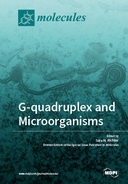Explore

G-quadruplexes (G4s) are nucleic acids secondary structures that form in DNA or RNA guanine (G)-rich strands. In recent years, the presence of G4s in microorganisms has attracted increasing interest. In prokaryotes, G4 sequences have been reported in several human pathogens. Bacterial enzymes able to process G4s have been identified. In viruses, G4s have been suggested to be involved in key steps of the viral life cycle: They have been associated with the human immunodeficiency virus (HIV), herpes simplex virus 1 (HSV-1), human papilloma virus, swine pseudorabies virus, and other viruses’ genomes. New evidence shows the presence of G4s in parasitic protozoa, such as the causative agent of malaria. G4 binding proteins and mRNA G4s have been implicated in the regulation of microorganisms’ genome replication and translation. G4 ligands have been developed and tested both as tools to study the complexity of G4-mediated mechanisms in the viral life cycle and as therapeutic agents. Moreover, new techniques to study G4 folding and their interactions with proteins have been developed. This Special Issue will focus on G4s present in microorganisms, addressing all the above aspects.
This book is included in DOAB.
Why read this book? Have your say.
You must be logged in to comment.
Rights Information
Are you the author or publisher of this work? If so, you can claim it as yours by registering as an Unglue.it rights holder.Downloads
This work has been downloaded 283 times via unglue.it ebook links.
- 210 - pdf (CC BY-NC-ND) at Unglue.it.
Keywords
- Alphaherpesvirinae
- alphaherpesviruses
- Aptamers
- Bacteria
- Bioinformatics
- co-transcriptional folding
- co-translational refolding
- conformational dynamics
- deinococcus
- DNA
- EBNA1
- Epstein-Barr virus (EBV)
- eukaryotic hosts
- fluorescence
- folding
- G-quadruplex
- G-quadruplex formation
- G-quadruplex ligand
- G-quadruplexes
- G4
- G4Hunter
- Genome
- genome evolution
- genome stability
- Herpesviridae
- Herpesvirus
- human papillomaviruses
- immediate early promoters
- metastable structure
- microbes
- NDPK
- NMR
- Nucleic acids
- nucleic acids conformation
- nucleoside diphosphate kinase
- PhenDC3
- protein-mRNA interactions
- protein–DNA interaction
- protozoa
- pseudorabies virus
- pyridostatin
- RecQ helicase
- regulatory element
- S. cerevisiae
- Structure
- structure-activity relationship
- translation suppression
- turn-on ligands
- virus
Links
DOI: 10.3390/books978-3-03921-244-6Editions


